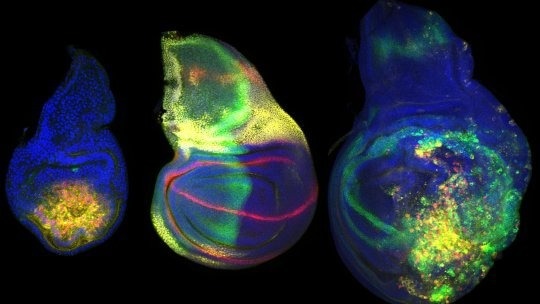Researchers at IRB Barcelona, under the direction of Dr Marco Milan, have identified a very robust system that insects use for wing formation and regeneration.
 Wingless expression (red) in regenerating (left), developing (center) and tumorigenic (right) wing primordia of Drosophila. Image Credit: Institute for Research in Biomedicine
Wingless expression (red) in regenerating (left), developing (center) and tumorigenic (right) wing primordia of Drosophila. Image Credit: Institute for Research in Biomedicine
The connection between the wingless gene, tissue regeneration, and tumor development has also been confirmed by the researchers.
The scientific journal Nature Communications has published their work.
Following the observation of flies without wings, the first mutation of the wingless gene was accidentally discovered in Drosophila in the 1970s, giving rise to the gene’s nickname. The wnt gene family was established when it was discovered fifteen years earlier that the gene was conserved in mammals. Different forms of cancer are brought on by wnt gene mutations.
The wnt gene family, including its founder member—the wingless gene, controls a number of activities throughout the embryonic development of both insects and mammals. If this is the case, then why did the first mutation of the wingless gene observed only harm the wings of Drosophila flies? The IRB Barcelona Development and Growth Control lab posed this query.
The researchers identified an evolutionarily conserved genomic region that controls the production of the Wingless protein solely during the development of the wing using gene editing methods like CRISPR/Cas9.
The researchers found that this regulatory area not only primarily promotes wing development but also regenerates the wings after damage using functional assays.
Ensuring wing formation in different ways
The study’s findings indicate that this regulatory region is solely responsible for controlling Wingless expression throughout wing development. Additionally, two highly redundant modules that are activated by separate signaling pathways were found in this regulatory area by their functional assays.
What we have discovered in this study is a highly robust genetic regulation mechanism that ensures proper wing development, and this mechanism is consistent with the crucial importance that these structures have for insects in general. Wing development was an enormous evolutionary advantage for insects and it is what permitted their expansion and diversification.”
Dr Marco Milán, Study Lead and Head, Development and Growth Control Laboratory, Institute for Research in Biomedicine
Regeneration and tumors
When an organ is damaged, the damaged cells communicate with the cells around them, causing the surrounding cells to divide and repair the organ.
The authors of this study have demonstrated that Wingless is also the molecule that signals healthy cells to divide and regenerate tissue, and that damage-induced activation of the regulatory area involved in wing formation also causes Wingless to be expressed.
The study team proved through functional experiments that the JNK stress signaling pathway duplicates its effects on the two already present modules.
Elena Gracia-Latorre and Lidia Pérez, the initial research authors, stated, “Once again, a very robust genetic regulatory mechanism ensures not only the correct development of the wing but also its ability to regenerate.”
As a concluding point, the researchers carried out tests in which they inhibited the removal of injured cells and discovered that the Wingless regulatory zone continued to be activated. Wingless’ continual presence caused the cells to multiply out of control, which eventually resulted in the establishment of tumorous and malignant growths.
Dr Milán concluded, “This allows us to propose that regeneration and tumor development are two sides of the same coin: if Wingless is induced for a short period of time, it forms the wing normally or allows it to regenerate, but if it is maintained chronically, then it causes overgrowth and a tumor.”
Source:
Journal reference:
Gracia-Latorre, E., et al (2022) A single WNT enhancer drives specification and regeneration of the Drosophila wing. Nature Communications. doi:10.1038/s41467-022-32400-2